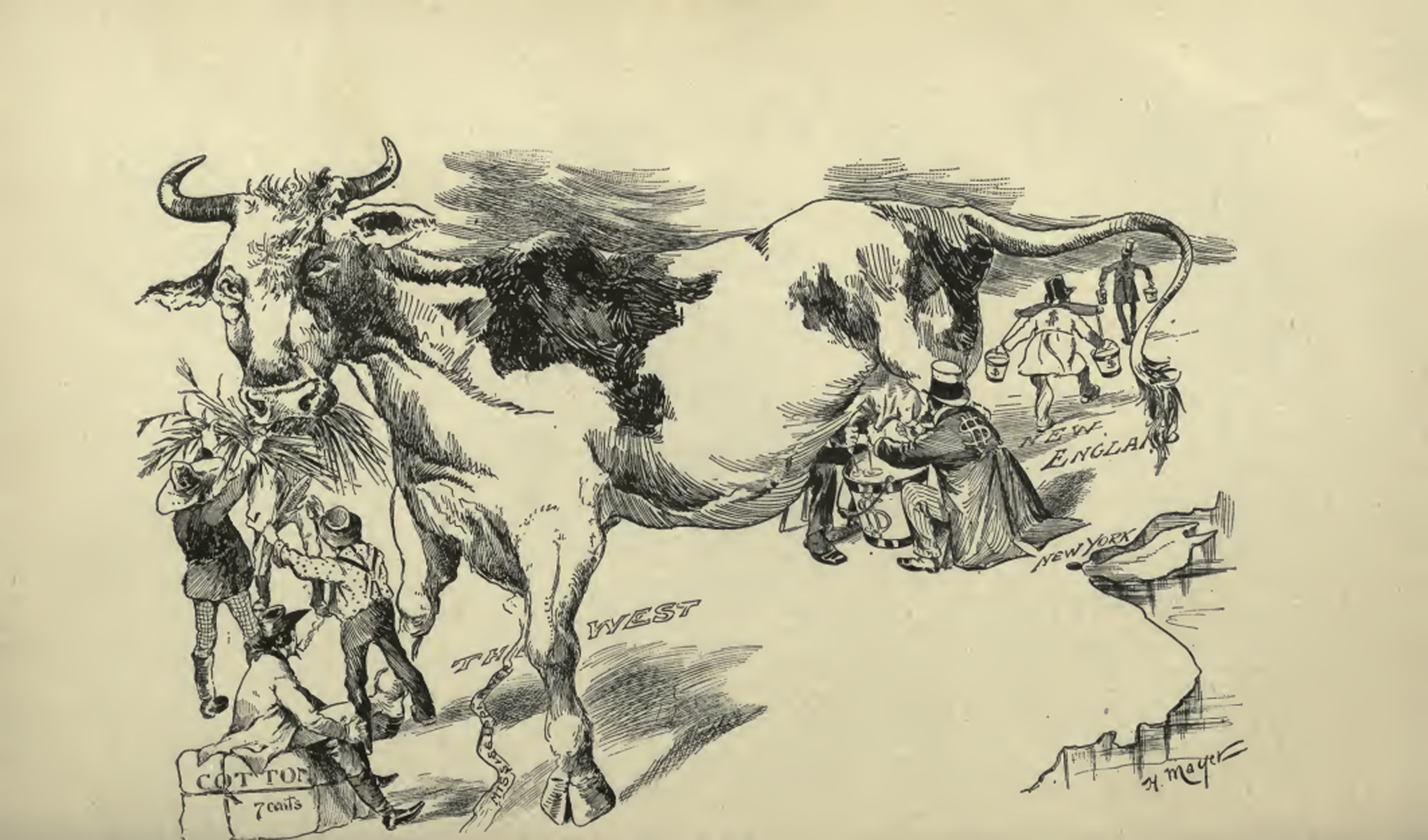Henry Moyer, “The National Cow” (cartoon), Coin’s Financial School, 1894
In 1894, a Populist writer named William H. Harvey (1851–1936) published Coin’s Financial School, an introduction to “bimetallism,” the idea that the U.S. government should increase the supply of money by coining silver as well as gold. Harvey, born on a West Virginia farm in 1851, had become a successful lawyer and economic reformer. Known for its clear and compelling explanation of complex financial ideas, Harvey’s book circulated widely through Populist networks in the 1890s, offering ordinary people an alternative explanation of the hardships they faced.
Following the cartoon is a short excerpt from a memoir by Mitchell Garrett (1881–1959), who grew up in a large farming family in the community of Hatchet Creek in east central Alabama. He was able to go to college in Birmingham and become a history professor. Just before his death, he published a memoir of his childhood, which mentions this cartoon.

Mitchell B. Garrett, Horse and Buggy Days on Hatchet Creek: An Alabama Boyhood in the 1890s
Pa frequently discussed in my hearing the political and economic condition of the country, and naturally I accepted his conclusions as authoritative and definitive. If I understood him aright, he was saying that what we needed to extricate ourselves from the oppression of the merchant in the South and the big moneyed man in the North was free coinage of silver at the ratio of sixteen to one. I did not comprehend the meaning of this magic formula, of course, but I had not the slightest doubt that in it lay the solution of all our problems. When the Farmers’ Alliance movement struck Clay County around 1888, Pa was inclined to give it his full approval. . . .
Someone distributed in the Hatchet Creek community free copies of a cheap, paper-covered book entitled Coin’s Financial School, which advocated the free coinage of silver at the ratio of sixteen to one. Nearly everybody thumbed through the book, even the children. I could not follow the argument; I bogged down in the statistics; but I could understand the pictures. Here was the picture of an immense cow superimposed upon the map of the United States. Her head was in Kansas and her hindparts in New England. Energetic Western farmers were feeding the cow great quantities of hay and grain, while a disconsolate Southern farmer sat nearby on a bale of cotton labeled “7 cents.” At the other end of the cow pig-faced gentlemen in top hats and long coats milked the cow and carried away the milk in huge pails labeled with dollar marks. . . . Now here was something concrete and comprehensible: The farmer and the industrial laborer did all the work, but those pig-faced gentlemen up North got all the gravy. . . .
Source: Mitchell B. Garrett, Horse and Buggy Days on Hatchet Creek: An Alabama Boyhood in the 1890s (Tuscaloosa: University of Alabama Press, 2003 [1957]), 221–22, 227.
Evaluating the Evidence
Question
sZ/e6+svHMcKilS6NgTMdCixVpjuTPRS1KNM8bovKNzasroU07va7+d3Qb4jlmJ6R/sm8cs4IA+6i5+NL6H+Ft+dFtRTFiCTFoXIk9aqsyMIe64zFR+NSdrQrjA3jMoLwHgEJZDXpcDcsg6dFM1x5szpjJKB+fXo2ftL8wYdmOyCpIKTLQ7OpkvYZ2IycVbzR5gkq3dysoFyXKEzCuL7MnPiVt/mvpixur10bVZCZUfYHqzA2Wu9G3Ykfzhj95WiIg+wJtcdESsAK0CWMYS8/1oIGdyrilueEDopXc6FQh9d8FI6h9rDv3/6vp7OCGThNJVcvJlH+1JPZ6tKunl4QbPuHwsMk5D53utlImQTYOtdFEmfQuestion
JiTCuFKZup8+nVxURTbLB4r0putk4LhKegImslYsHQwBEoWF1RBwCQLDuKnlalJfBXuONdPbe3w1a9pswfoMW++BK7xyuesR30ZPw7aRh/ZryCvIvbMCfcL9ziDP1WwrikzPFWBam0GttUMuBSuDM5N1m0vA/sx8v4IR9I87WTiNImscD3Ix786W70Uth90t94sDxHZyLch5wRrjWuu/p/ZJNS7v8wpeMBDet91LM1kZzYNU5ZB3vA==